
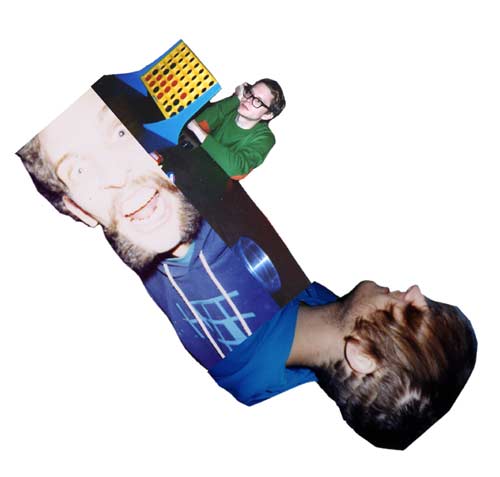
shinths 2003!!!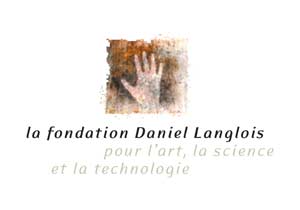
funded by the Daniel Langlois foundation, I built some instruments called shinths. I went on tour with them and some guest musicians during November and December: Jacques Perron from the FDL wrote an essay about the project which you can read here. nov 13: Chicago live on WZRD 88.3, 15 Chicago at Heaven, 16 Detroit at The Lager House, 17 Cleveland at The Hi-Fi, 18 Pittsburgh at Quiet Storm, 19 New York at Deitch Projects, 20 Easthampton at Flywheel, 21 Providence at the RISD Tap Room, 22 Baltimore at 14 Karat Cabaret, 23 Knoxville at The Pilot Light, 24 Nashville at the Springwater Supper Club, 25 Chapel Hill at The Nightlight, 26 Louisville at the Rudyard Kipling, 27 St. Louis at Lemp Arts, 28 Houston at Super Happy Funland, dec 1 San Diego at Che Cafe, 3 San Francisco at The Hemlock Tavern, 4 San Francisco at The Art Institute of San Francisco, 5 Portland at Kingdom, 6 Seattle at The Haunt, 7 Olympia at Lucky 7, 8 Missoula at Area 5, 10 Kansas City at The Bank, 11 Minneapolis at Mala, 12 Madison at 2310 Projects, 14 Chicago at The Empty Bottle...
I had asked twig and f.f. to play the shinths with me tagteam style - sometimes we played solo and sometimes we teamed up. they also brought their own devices and dead electronics along. Twig brought some instruments he had made out of toys, spray painted orange and yellow and melted all over. f.f. brought several of his black boxes, which are some sort of remix of simple circuits, with a few unlabeled knobs sticking up... hear twig play the shinths in missoula
hear twig play the shinths at the SF art institute
(2)
hear me play the nabra in olympia
listen to fashion flesh and me shinth-voicing in
sf After we finished a set, we would usually put two shinths out with a stereo and some five-minute blank tapes, so people could make their own mixtapes. People loved coming up and playing the shinths, and they learned to play very quickly. It's a tool that needs no language to learn - there are no labels on it because there is no specific interface. Even people who seemed to not enjoy or understand the show could really get into playing the shinths. We only needed to give one warning - don't touch any metal to the surface. For some people, I took down their names, and confiscated the mixtape that they made, so I could put it up here:
|
|
|
the accident is no longer to be identified solely with its disastrous
consequences, its practical results- ruins and scattered debris- but
with a dynamic and energetic process, a kinetic and kinematic sequence
that has nothing to do with the vestiges of objects destroyed, with
wreckage and rubble... a way of showing what happens in what crops up
out of the blue... It would be a matter of creating a new kind of scenography
in which only what explodes and decomposes is exposed. A paradoxical
mise-en-scène of the obscene in which decomposition and disintegration
would supersede the compositions of advertising and high-tech "design". |
The shinths are intuitive electronic surfaces. They look like the shipwrecked flotsam that washes onto beaches, and they are similar electronically; their original intentions "never existed", and now they can only be used for something else. Like a beachcomber carving a duck out of driftwood, I asked circuit benders to make sound out of the shinth. It was a collaboration: I designed an ambiguous and apparently meaningless electronic system, and the circuit benders created intuitively and spontaneously by bending or breaking the flip side. |
|
To make a shinth, you must eliminate all intentions or hierarchy or
goals. In electronic design this is difficult because practicality has
overwhelmed the field- there are no wandering paths in it anymore, just
straight ones to a well defined goal. This "goal-oriented"
design has penetrated the whole field of electronics, so that hierarchical
thinking marks every stage of the process; the design process has a
hierarchy (plan, test, build), as well as the object designed (input,
process, output). In the shinth, there is no heirarchy, or at least
none reveals itself, and no one process claims to structure the others.
One exercise was to realize a building block I call a shircuit. Designing
a shircuit, you get lost; as you experiment with the materials, they
suggest their own systems, and you forget why you're doing it in the
first place. it's like staring at an object until it becomes a non-object.
The shircuits have different flavors, but they do not line up well with
traditional synthesizer terms because they are created from their materials
and not for their results. They owe their existence to distillations
of miniature and myopic design procedures rather than a masterminded
plan. The shinth is made up of a web of shircuits: non-circuits make
up a non-synthesizer. I made a board of them, and then connected them
until I didn't know what was going on, just like with the nabra. when
it reached the pond-animal intuitive point, I knew it could be intuitively
played, because all parts were reacting somehow but no one knows how.
if any metal touches the face of the shinth, there's a chance parts of it could break. at every show where we let the locals play the shinths, we made sure to keep an eye on them to make sure they didn't touch the spoons to the board. every once and a while, though, some people slipped through without the warning to never touch metal to the circuit board. in kansas city, some dude was rubbing the spoon on the circiut board for a few minutes. after, i checked the sounds of the particular shinth. it was broken, for certain, but it still made sounds. as i listened more I noticed that the sounds had mutated to a madder variety than the original ones. | |

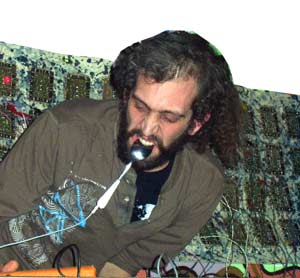
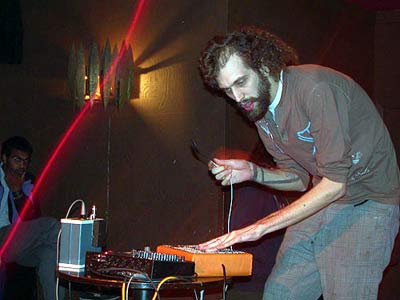
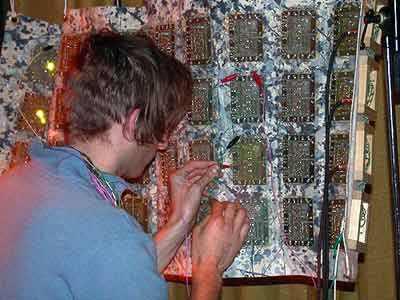 I usually
had trouble explaining how the nabra, the rollable synthesizer works.
but I did use it to demonstrate how the shinths work. After a certain
point, when there are so many bundles of patches hanging from it, planned
routing gives way to intuitive rearranging. I don't know how the structure
works anymore, and I'm just listening to the effect of moving patches
around, like if you had a palette of pond animals that each had multiple
compatable orifices... The interiors of the shinths work this way. They
are made up of a bunch of building block analog automata, patched for
a while according to some logical connections, and then superpatched
into chaos...
I usually
had trouble explaining how the nabra, the rollable synthesizer works.
but I did use it to demonstrate how the shinths work. After a certain
point, when there are so many bundles of patches hanging from it, planned
routing gives way to intuitive rearranging. I don't know how the structure
works anymore, and I'm just listening to the effect of moving patches
around, like if you had a palette of pond animals that each had multiple
compatable orifices... The interiors of the shinths work this way. They
are made up of a bunch of building block analog automata, patched for
a while according to some logical connections, and then superpatched
into chaos... This
photo is from the installation we did in deitch projects. I didn't play
the nabra at deitch - I just hung it up and let it run alongside a few
shinths left out for people to play. But at every other show, I played
the nabra live, patching it from scratch. Often Twig would play a solo
noisy set in the middle of our show, then we would have a break. During
the break I would start setting up the nabra, developing feedback control
structures, and starting to make small sounds. During this people would
usually still be talking, and often asking me questions on what I'm
doing. There came an undefinable point, though, where the nabra's sound
became active and the audience stopped talking. This was a fun way to
perform, to gradually fade from audience to nabra.
This
photo is from the installation we did in deitch projects. I didn't play
the nabra at deitch - I just hung it up and let it run alongside a few
shinths left out for people to play. But at every other show, I played
the nabra live, patching it from scratch. Often Twig would play a solo
noisy set in the middle of our show, then we would have a break. During
the break I would start setting up the nabra, developing feedback control
structures, and starting to make small sounds. During this people would
usually still be talking, and often asking me questions on what I'm
doing. There came an undefinable point, though, where the nabra's sound
became active and the audience stopped talking. This was a fun way to
perform, to gradually fade from audience to nabra.
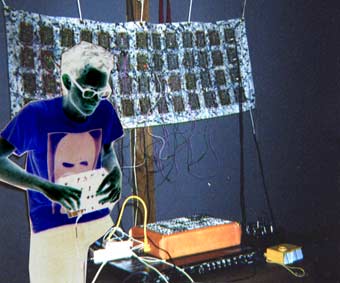 fashion
flesh liked to talk the shinthsss - he would lick and kiss and tap the
spoon and make syncopated patterns out of his mouth contact with the
beast... often it sounded too much like the shinth was saying something
so twig and I couldn't help but say something back.
fashion
flesh liked to talk the shinthsss - he would lick and kiss and tap the
spoon and make syncopated patterns out of his mouth contact with the
beast... often it sounded too much like the shinth was saying something
so twig and I couldn't help but say something back.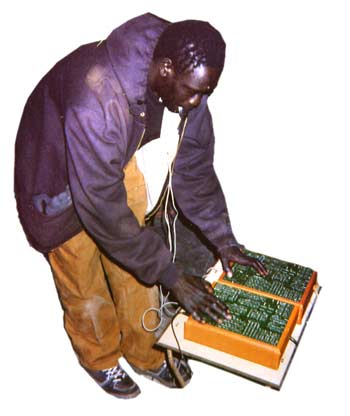
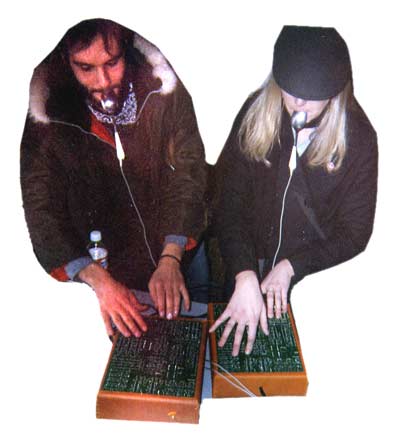

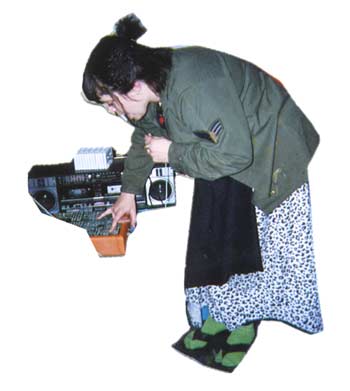
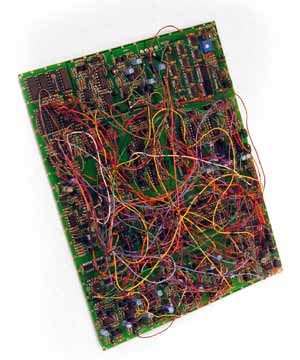 the
shinth has an interior, which is designed to criteria which are now
completely unknown. No one knows in what imaginary machine it worked;
no one knows if it was intended to measure or control; no one knows
if it supervised navigation, communication, or waste disposal.
the
shinth has an interior, which is designed to criteria which are now
completely unknown. No one knows in what imaginary machine it worked;
no one knows if it was intended to measure or control; no one knows
if it supervised navigation, communication, or waste disposal.
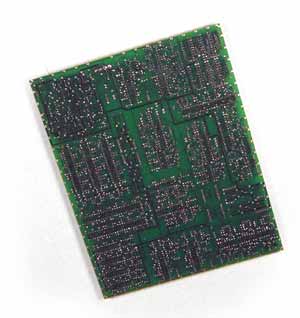 On
the flip side of the shinth plane, any visible structure disappears,
and procedure dissolves into intuition. In the intuitive plane, the
intentions of the inst do not matter. The shinth will electronically
decay on this side- circuit benders might be able to unknowingly break
electronic systems. This does not necessarily silence the shinth, but
hopefully it will make it richer.
On
the flip side of the shinth plane, any visible structure disappears,
and procedure dissolves into intuition. In the intuitive plane, the
intentions of the inst do not matter. The shinth will electronically
decay on this side- circuit benders might be able to unknowingly break
electronic systems. This does not necessarily silence the shinth, but
hopefully it will make it richer. 